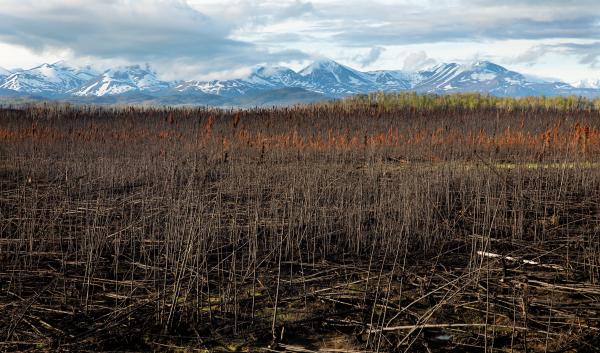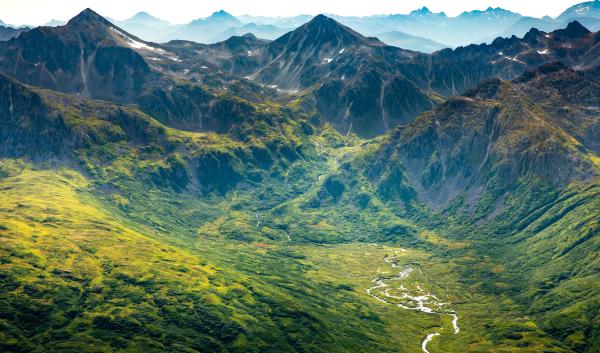Spruce beetle outbreaks have affected nearly 2 million acres of spruce forest in Southcentral Alaska since 2016. This outbreak coincides with rising temperatures and increasing instances of drought associated with climate change. These conditions create a more favorable environment for spruce beetles, accelerating their life cycle and making trees more vulnerable to infestation. In the Seward Ranger District on the Kenai Peninsula, the Chugach National Forest is combatting outbreak impacts by removing hazardous trees and fuel to improve forest health, reduce wildfire risk, and ensure the safety of visitors and wildlife.
Reading Time | 7 minutes
Management Goals | Reduce hazards associated with spruce beetle outbreaks on the Chugach National Forest
Audience | Land managers, foresters
Project Contact |
Ruth D’Amico, Seward District Ranger; Tracy Christopherson, Project Manager
Project Area | Kenai Peninsula, Alaska
Funding | See funding section
Rising Temperatures and Drought Contribute to Spruce Beetle Outbreaks

Spruce beetle outbreaks are not uncommon in Alaska. However, climate change is increasing the scale of outbreaks, intensifying impacts on spruce forests. Rising temperatures allow some spruce beetles to complete their life cycle in one year instead of two, meaning more beetles can reproduce in a shorter period of time. Milder winters, with fewer hard frosts, allow more juvenile and adult beetles to survive the winter. This reduces the natural decline of the beetle population each year. Rising temperatures and drought also weaken spruce trees, making them more susceptible to spruce beetle infestation. Larger spruce beetle populations mean a greater likelihood of large-scale infestation in Alaskan forests.
The Spruce Beetle Outbreak in Chugach National Forest: Impacts and Concerns
Since 2016, an extensive spruce beetle outbreak fueled by these circumstances has affected nearly 2 million acres of forest in Southcentral Alaska, including 250,000 acres within the Seward Ranger District of the Chugach National Forest. Notably, this outbreak overlaps significantly with the footprint of a similar million-acre outbreak that occurred in the 1990s. The occurrence of two major outbreaks in the same area within a 40-year timeframe is uncommon and highlights a potential increase in the frequency of large-scale outbreaks.
The most recent outbreak caused widespread mortality of spruce trees and reduced tree size and density on the Chugach National Forest. Though spruce beetles typically target larger trees (8-10 inches in diameter), smaller trees (3-7 inches in diameter) can also be affected in large outbreaks. In the most recent outbreak, 55% of trees over 9 inches in diameter were killed, while 40% of trees between a 5- and -9-inch diameter were killed. The most impacted stands exceeded 85% mortality rates in both smaller and larger trees. When smaller, younger trees are damaged or killed, it can take longer for a forest to recover. The Forest Service is investigating the impact of the most recent outbreak on tree growth and forest composition. This information will help determine how the Chugach might recover.
Wildfire — A large-scale outbreak can have widespread consequences that extend beyond the immediate harm to the trees. For instance, outbreaks can alter vegetation in a way that increases the risk and severity of wildfires. During certain periods following an outbreak in which large numbers of trees die, fuel characteristics (e.g., fine fuels in the form of small branches or larger fuels from fallen trees) change and can increase fire hazard and/or severity.

Water — Spruce beetle outbreaks can also affect water flow in the ecosystem. When trees die, they no longer absorb water from the soil. This can lead to increased surface runoff after rain or snowmelt, resulting in higher and earlier peak flows in streams and rivers. Dead trees also lose their ability to transpire water back into the atmosphere. This can lead to a temporary increase in the overall amount of water flowing through the system, also known as water yield. It is important to note that these are potential impacts based on research from other regions, and specific studies are still needed to understand the effects of spruce beetle outbreaks on hydrologic conditions in Southcentral Alaska.
Wildlife — Wildlife can also be affected by outbreaks. Some species may benefit from increased insect activity (e.g., woodpeckers), or from the understory growth and forage created by the openings in the forest canopy (e.g., alder flycatcher, dark-eyed junco). However, species that rely on spruce trees for shelter or food, (e.g., red squirrels and Townsend’s warblers) can suffer during outbreaks.
Human health and safety — Dead spruce that are standing or fallen can pose a threat to human safety, reduce access to recreational sites and wild foods, and limit access to disaster egress routes. An outbreak can also significantly alter the appearance of the forest, which can affect visitors’ sense of place and connection to the landscape.
Removing Hazard Trees Can Enhance Forest Health and Visitor Safety
Climate change is likely to increase the frequency of spruce beetle outbreaks in Southcentral Alaska. In response, the Chugach National Forest is taking measures to support forest health and address safety concerns arising from affected trees. An interdisciplinary team, including forest managers and subject matter experts such as fire and fuels specialists, has planned treatments that include removal of fuels and hazard trees, forest thinning, prescribed fire, and silviculture treatments that promote growth and retention of hardwood species. These treatments can reduce safety hazards and wildfire risk to communities and ensure access to transportation routes and popular recreation sites.

To improve safety and visitor experience, the first phase of this project focused on removing hazardous trees and excess fuel from 250 acres around popular recreation areas along the Seward Highway. These areas include campgrounds and trailheads. The project is expected to be completed in 2024 through a combination of contracted services and partnerships with local organizations, including the Alaska Native non-profit Chugachmiut and the Alaska Native corporation Salamatof.
The completed work has already yielded positive results. Campgrounds are now safer for visitors, with improved visibility of the surrounding scenery. Additionally, the removal of dead trees and brush has enhanced wildlife visibility, potentially reducing the risk of unwanted interactions between humans and animals.
Plans for the Future
The Chugach National Forest has planned future phases for this project, aiming to achieve the following goals:
- Reduce fuel loads
- Reduce fire hazards to communities
- Protect riparian areas (zones alongside streams and rivers)
- Manage habitat to promote healthy wildlife populations and provide public values such as wild-harvest and recreation
- Maintain soil health on treated sites
The second phase of the project, encompassing 12,581 acres, is currently underway and expected to be completed by 2028. Overall, the project aims to treat 3,000 acres within that larger phase 2 footprint.
The vast area affected by the current spruce beetle outbreak requires large-scale management strategies. As the project progresses, future phases will need to address existing threats and enhance forest resilience against future outbreaks on a broader scale. These future treatments will be guided by continuous monitoring of resources and will consider potential future changes, such as evolving wildfire patterns and vegetation impacts due to climate change, within the Seward Ranger District.
Challenges and Opportunities
The vast scale of the spruce beetle outbreak presents significant challenges for effective management. Addressing it requires coordinated action across diverse land ownerships within an expansive landscape. Several additional factors limit the project's scope and pace. Limited funding and personnel resources constrain the project's ability to address the widespread outbreak. Additionally, ground-based equipment is limited to winter use on certain project sites due to concerns about damage to soil and cultural resources. Furthermore, the Chugach National Forest manages for various public uses under its multiple-use mandate. Balancing these diverse needs, such as cultural resource protection alongside outbreak response, requires careful planning and resource allocation.
Despite these challenges, the Chugach National Forest is taking action. They are addressing the most pressing challenges first, such as protecting the public from hazard trees at popular campgrounds and recreational sites. This approach helps them address immediate safety concerns and creates a foundation for securing additional resources to tackle future challenges.

The Forest is also taking the opportunity to use this project to provide free firewood to community members and facilitate commercial firewood sales. Furthermore, the Forest is strategizing with partnership coordinators, the Forest Tribal liaison, and staff in State, Private, and Tribal Forestry to explore economically viable ways to utilize biomass beyond firewood harvest. The Chugach National Forest has invested in an air curtain incinerator as a biomass utilization option that can reduce pile burning of small-diameter, low-value wood, thus minimizing smoke emissions in the area. For other national forests dealing with insect and disease outbreaks, the Chugach National Forest team highly recommends that forests partner with staff from their fire and fuels departments. In this way, they can leverage expertise, pool funding, and build partnership agreements for efficient project implementation.
A More Resilient Chugach
The projected effects of climate change will almost certainly make spruce beetle outbreaks an ongoing, perhaps worsening, challenge for sustainable resource management. At a minimum, the impacts of spruce beetle outbreaks will continue to require long-term monitoring. By responding to the current spruce beetle epidemic and implementing proactive measures, the Chugach National Forest is working to reduce the impacts of spruce beetle outbreaks, create a healthier and more diverse forest, and ensure the safety of both visitors and wildlife.
Alaska Spruce Beetle Webpage – this page provides information about biology, identification, management, and outbreak status of spruce beetles in Alaska. It is a partnership between the US Forest Service, University of Alaska-Fairbanks Cooperative Extension Service, and Alaska Department of Natural Resources.
Alaska Forest Health Highlights 2022 – This webpage highlights the health of Alaska’s forests on a yearly basis. The page covers a variety of insects in the state.
NEPA Planning Pages for Phase 1 NEPA and Phase 2 NEPA for the spruce beetle mitigation project.




